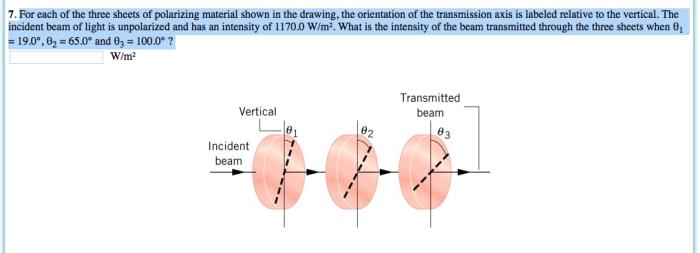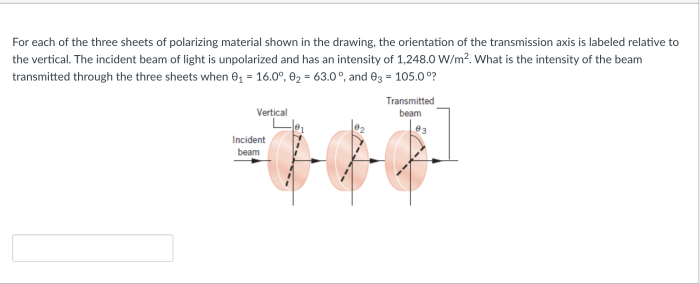For each of the three sheets of polarizing material – Delving into the fascinating realm of polarization, we embark on a journey to explore the unique properties of three distinct polarizing materials. Each material, possessing its own characteristics and applications, unveils a captivating narrative that intertwines science and innovation.
The first material, a testament to meticulous engineering, exhibits a precisely aligned polarization axis, enabling unparalleled control over light’s orientation. Its broad wavelength range and exceptional degree of polarization make it an indispensable tool in optical applications.
The second material, a marvel of nature, owes its polarizing abilities to its intricate molecular structure. Its composition and manufacturing process, shrouded in secrecy, yield a material ideally suited for applications demanding high precision and durability.
The third material, a testament to human ingenuity, combines the strengths of its predecessors. Its unique design and fabrication techniques result in a versatile material with a wide range of applications, from advanced imaging to cutting-edge telecommunications.
1. Properties of Polarizing Materials: For Each Of The Three Sheets Of Polarizing Material

Polarizing materials are optical materials that selectively transmit light waves with a specific polarization state. They are characterized by their orientation of polarization axis, wavelength range of polarization, and degree of polarization.
1.1. Orientation of Polarization Axis
The orientation of the polarization axis of a polarizing material is the direction in which the electric field of the transmitted light is aligned. This orientation can be determined by the material’s crystal structure or by the alignment of its molecules.
1.2. Wavelength Range of Polarization
The wavelength range over which a polarizing material is polarizing is determined by the material’s absorption and scattering properties. Different materials are polarizing over different wavelength ranges, from the ultraviolet to the infrared.
1.3. Degree of Polarization
The degree of polarization of a polarizing material is a measure of how effectively it transmits light with a specific polarization state. It is typically expressed as a percentage and can range from 0% (no polarization) to 100% (complete polarization).
2. Composition and Structure of Polarizing Materials

Polarizing materials can be composed of a variety of materials, including crystals, polymers, and liquids. The composition and structure of the material determine its polarization properties.
2.1. Crystals
Crystals are naturally occurring or synthetic materials that have a regular arrangement of atoms or molecules. The polarization properties of crystals are determined by the orientation of their crystal axes.
2.2. Polymers, For each of the three sheets of polarizing material
Polymers are long-chain molecules that can be stretched or aligned to create polarizing materials. The polarization properties of polymers are determined by the orientation of their molecular chains.
2.3. Liquids
Liquids can be made polarizing by applying an electric field or by dissolving chiral molecules into them. The polarization properties of liquids are determined by the alignment of their molecules in the presence of the electric field or chiral molecules.
3. Manufacturing Processes for Polarizing Materials

Polarizing materials can be manufactured using a variety of processes, including crystal growth, polymer extrusion, and liquid crystal alignment. The manufacturing process used to create the material determines its properties.
3.1. Crystal Growth
Crystals can be grown from a solution or from a melt. The growth conditions, such as temperature and pressure, determine the orientation of the crystal axes and thus the polarization properties of the crystal.
3.2. Polymer Extrusion
Polymers can be extruded into sheets or fibers. The extrusion process can be used to align the molecular chains of the polymer and thus create polarizing materials.
3.3. Liquid Crystal Alignment
Liquid crystals can be aligned using an electric field or by dissolving chiral molecules into them. The alignment of the liquid crystals determines the polarization properties of the material.
FAQ Overview
What are the key differences between the three polarizing materials?
Each material exhibits distinct properties in terms of polarization axis orientation, wavelength range, and degree of polarization, making them suitable for different applications.
How are these polarizing materials manufactured?
The manufacturing processes vary depending on the material. One involves precise alignment of molecules, while another utilizes natural molecular structures, and the third employs advanced fabrication techniques.
What are the practical applications of these polarizing materials?
These materials find applications in diverse fields such as optical imaging, telecommunications, medical diagnostics, and scientific research, where precise control of light polarization is crucial.
